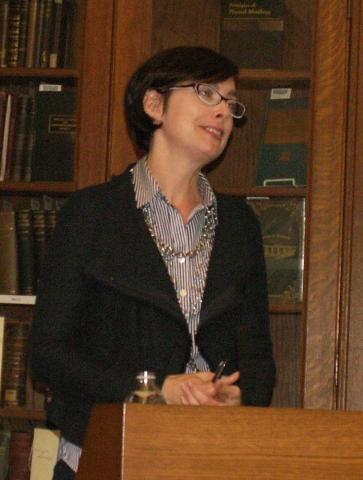
What if we used the term “nature” instead of “environment”? What would it look like to have a department of nature studies? Why do we so frequently turn to silent depictions of nature, while medieval literature and natural philosophy found it thinkable to personify Nature as a talkative woman? What do we lose when we no longer let nature speak?
These are a few of the questions that Prof. Kellie Robertson explored in her recent talk, the third of the Lehigh Humanities Center PostHUMANities speaker series. Carefully weaving together extensive knowledge of modern environmental criticism and medieval traditions, Prof. Robertson argued that medieval representations of nature have enduring significance for how we understand human connections to the natural world.
Part of her newest book project, Nature Speaks: Medieval Literature and Aristotelean Philosophy, Prof. Robertson’s lecture argued for a more generous consideration of medieval portrayals of nature that we might easily dismiss today as too sentimental, causal, or human-centric—like the anthropomorphized birds in Chaucer’s Parlement of Foules. Prof. Robertson showed, in fact, that medieval poets and philosophers use the personification of nature to explore complex issues of determinism and volition. Drawing on vertical scientific taxonomies of the natural world between the 13th through 16th centuries, personified figures of nature in the Middle Ages critique the desire to see human beings as exceptional. The ecological ethics of these thus medieval texts accommodate gradient continuities and differences among species. In doing so, they depart from many 21st-century posthumanist arguments that privilege horizontal connections among human beings and non-human life. As Prof. Robertson’s exciting work shows, this medieval perspective has something ethically and politically significant to offer modern ecological projects.
One of the gifts of Prof. Robertson’s talk—and one connection with the previous lecture by David Bates—was the reminder that, as we pursue an interdisciplinary investigation of the human and animal, we must also remember to think across and within historical distance. That is, there may be as much at stake ethically in considering how we frame the differences between ourselves and our historical relatives as there is in how we think across the boundaries of the human and non-human.
Please join us for the next talk in the PostHUMANities series, at the beginning of the Spring Semester: “Sentiment and Savagery: Collapsing the Boundary Between Animal and Children in U.S. History,” by Professor Susan Pearson, on January 29 at 4:10pm in Linderman Library 200.
